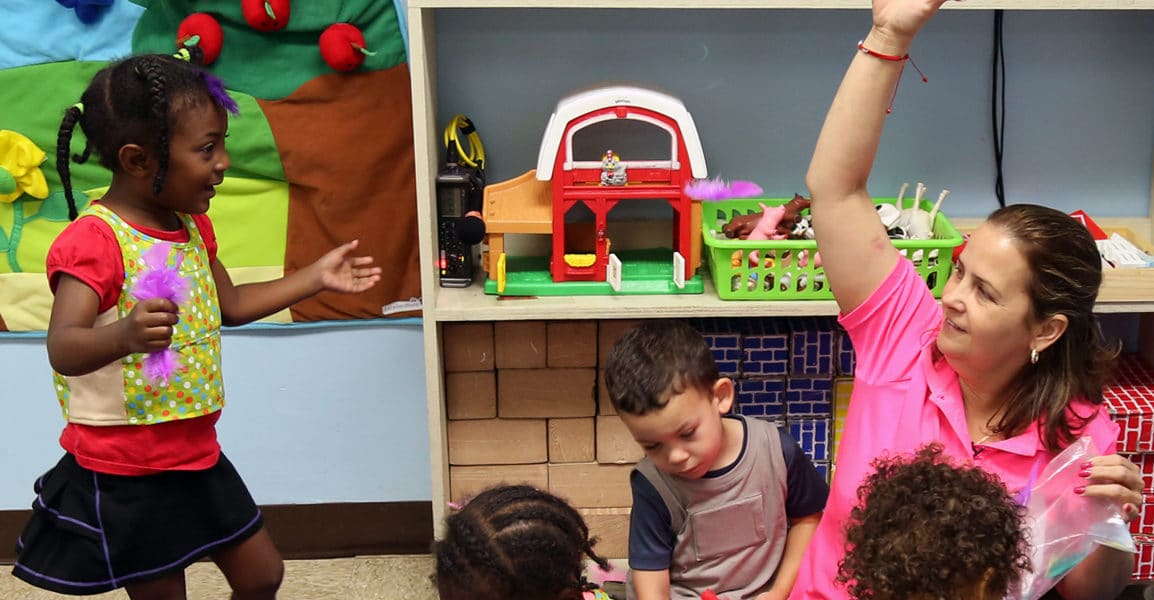Picture this scene: Your staff are tired, there’s been enough change for a lifetime, and everyone feels overworked. Now there’s a new program to implement — LENA Grow or LENA Start, for instance — but it’s proving hard to drum up excitement. How can you create enthusiasm to move your team into a new space of change, innovation, and fresh starts?
Early childhood organizations have had to remain agile as they’ve navigated the challenges of providing quality care and programming to families in the midst of a global pandemic. Many of these changes came about quickly and all at once. Early child care providers nationwide have searched for a sense of normalcy to feel confident and grounded in their work again.
For some, change amid challenge was welcomed. For others, it felt overwhelming, stressful, and energy-draining. All the while, leaders have been charged to think differently about accelerating their organization’s impact, ensuring that their communities are receiving the best service possible.
Even in a post-COVID world, these challenges won’t be going away. In child care settings, ensuring buy-in from staff will always be near the top of the to-do list.
There are certain strategies that can be utilized to inspire a spark, motivate teams, and build momentum for the new season ahead. Before we dive into those strategies, let’s talk about what engagement looks like when staff are fully bought in.
What does staff buy-in look like?
- Communication is consistent and clear: All staff can articulate the reason why this new strategy or program exists, the associated goals, and the role they’ll play. Regardless of who delivers the message, the communication is consistent across teams.
- Questions get asked: The staff asks questions that both support and challenge the new program. A leader authentically addresses the full spectrum of questions, knowing their responses can determine how well their staff further engages. Staff need the space to build context and clarity around the purpose of new initiatives.
- Ideas get shared: Staff members serve as active participants in moving the new program forward. They share personal perspectives after engaging the program and provide constructive feedback to move the program forward. There may also be increased signs of cross-collaboration among different teams.
Tips for building staff engagement
Share the why
Explain in detail what need the new initiative is addressing and how this change will help to bring a practical solution.
When introducing LENA Grow for the first time to her teachers in South Carolina, Cherokee County School District Assistant Principal Julie Foster explained how the program would benefit both teachers and students in the long term. She carefully walked through the benefits of how tracking the amount of early talk within their preschool classrooms has an effect on their students’ future academic readiness. She told her staff, “LENA Grow is something that will build your classroom foundation for years to come. What you chose to do in this moment affects your students in 8th grade.”
Model the way
Show others through your behaviors and actions what great implementation looks and feels like. Move away from talking about what to do and more toward showing your staff models of excellence. This includes sharing how you are personally connected to the work. Why does this change matter to you, and how you are committed to moving the work forward? The more you can authentically share your excitement and drive, the more likely your staff will want to do the same.
Lyana Vazquez, Director at Best Memories Academy in Orlando, Florida, does this well. “You have to love what you do before you ask others to do it,” she told her staff.
Keep it real
Communicating the truth across all facets of the organization sets a culture of authenticity and vulnerability that allows for real change to thrive. Communicate the challenges that you foresee and address concerns instead of avoiding them. It’s also important to frame questions that elicit authentic responses.
Leaders at the Virginia Child Development Resource Center saw a shift in intentionality in their teachers after they implemented LENA Grow. “What has come out of LENA Grow has been an increase in critical thinking that wasn’t really there before,” said Crystal Howser, “and it’s trickling over into other areas of their work.”
Lean into mistakes
When introducing a new program, it’s important to verbally acknowledge that mistakes will be made. Your response to a mistake is more important than the mistake itself. Who do you talk to? What is at stake? What supports are needed to create a solution? These are questions to think about when creating a path forward — a path that welcomes learning and professional growth.
Make space for reflection
Allot time within the workday and work week for staff to reflect. Spending 15-20 minutes to reflect on the lessons learned leads to better performance.
In North Carolina, Smart Start of New Hanover County used weekly LENA Grow coaching sessions as times to allow for teacher reflection. After reviewing LENA feedback reports, teachers were able to contextualize the data and set goals to increase classroom performance. One coach said, “Seeing the data and meeting one-on-one really helped to impact our teachers and not have them feel so flustered.”
Celebrate the process
Take time to recognize staff in their new responsibilities and create opportunities to affirm and acknowledge their strengths and actions.
Cherokee County School District did this by making every week a celebration, highlighting the increases in conversational turns they saw in their LENA Grow classrooms. Celebration music permeated the halls while LENA coaches danced and shouted out the accomplishments of both teachers and students. The school principal also made announcements over the intercom system to share early talk goals from every 3-year-old classroom. During the full LENA Grow sequence, teachers were given small gifts of appreciation for reaching milestones and were then given a larger graduation gift for successfully completing a full sequence.
What methods have you used to increase staff buy-in in your organization? We would love to hear your stories! Comment below or send us an email.



